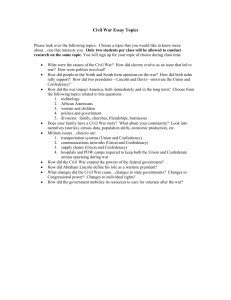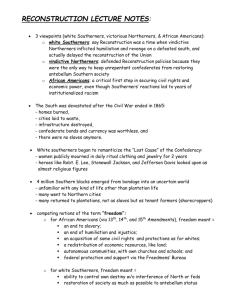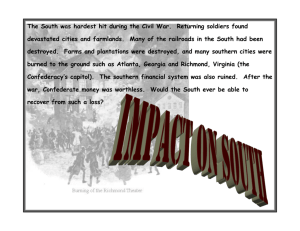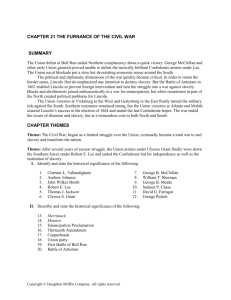Chapter 7—The Civil War And Reconstruction
advertisement
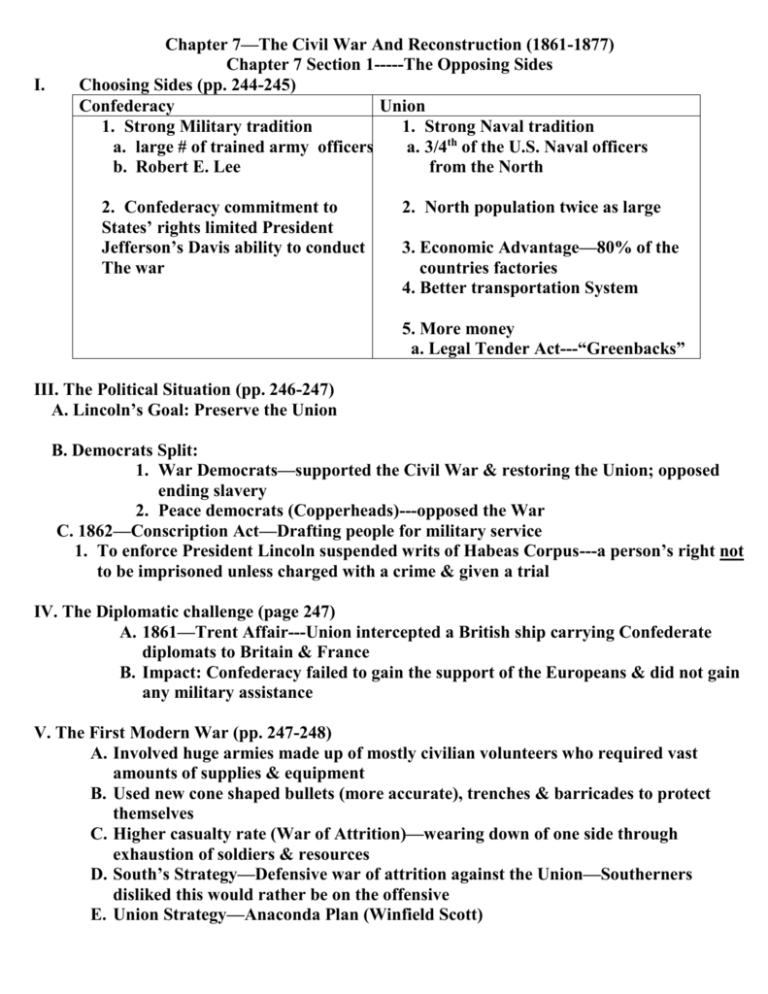
I. Chapter 7—The Civil War And Reconstruction (1861-1877) Chapter 7 Section 1-----The Opposing Sides Choosing Sides (pp. 244-245) Confederacy Union 1. Strong Military tradition 1. Strong Naval tradition a. large # of trained army officers a. 3/4th of the U.S. Naval officers b. Robert E. Lee from the North 2. Confederacy commitment to States’ rights limited President Jefferson’s Davis ability to conduct The war 2. North population twice as large 3. Economic Advantage—80% of the countries factories 4. Better transportation System 5. More money a. Legal Tender Act---“Greenbacks” III. The Political Situation (pp. 246-247) A. Lincoln’s Goal: Preserve the Union B. Democrats Split: 1. War Democrats—supported the Civil War & restoring the Union; opposed ending slavery 2. Peace democrats (Copperheads)---opposed the War C. 1862—Conscription Act—Drafting people for military service 1. To enforce President Lincoln suspended writs of Habeas Corpus---a person’s right not to be imprisoned unless charged with a crime & given a trial IV. The Diplomatic challenge (page 247) A. 1861—Trent Affair---Union intercepted a British ship carrying Confederate diplomats to Britain & France B. Impact: Confederacy failed to gain the support of the Europeans & did not gain any military assistance V. The First Modern War (pp. 247-248) A. Involved huge armies made up of mostly civilian volunteers who required vast amounts of supplies & equipment B. Used new cone shaped bullets (more accurate), trenches & barricades to protect themselves C. Higher casualty rate (War of Attrition)—wearing down of one side through exhaustion of soldiers & resources D. South’s Strategy—Defensive war of attrition against the Union—Southerners disliked this would rather be on the offensive E. Union Strategy—Anaconda Plan (Winfield Scott) 1. Blockade Confederate ports & send gunboats down the Mississippi River to divide the Confederacy Chapter 7 Section 2-----The Early Stages I. Mobilizing the Troops (pp. 249-250) A. First battle of Bull Run—Confederates defeated the Union—Led by “Stonewall Jackson” B. Both The Confederacy & Union instituted the draft due to lack of volunteers 1. North offered “bounty” to get volunteers to enlist for three years of military service II. The Naval War (pp. 250-251) A. Union established a Blockade of all Confederate Ports in an effort to cut the South’s trade with the world B. New Orleans—Captured David Farragut & gained control of the lower Mississippi River for the Union 1. South’s largest city & center of cotton trade III. The War in the West (page 251) A. Battles of Fort Henry & Fort Donelson---Union gained control of the Cumberland & Tennessee Rivers 1. Cut Tennessee in two & gave the Union a river route deep into Confederate Territory B. Battle of Shiloh---Grant’s advancement stopped by the Confederates 1. Union victory, but 20,000 men were killed or wounded IV. The War in the East (pp. 251-253)—Union Goal: Capture Richmond A. Seven Days Battle---Lee inflicted heavy casualties on the Union Army & forced McClellan to retreat back to Washington B. 2nd Battle of Bull Run---South forced the North to retreat—Confederates 20 miles from Washington, D.C. C. Battle of Antietam –Bloodiest one-day battle of the war 1. Turning Point for the Union Because: a. South lost its best chance to gain international recognition & support b. Convinced Lincoln that it was time to end slavery in the South V. The Emancipation Proclamation (page 253) A. Decree that would free all enslaved persons in states still in rebellion after January 1, 1863 B. Emancipation Proclamation changed the Civil War from a conflict over preserving the Union to a war to free the slaves VI. Life During the Civil War (pp. 253-254) A. Wartime Economies: 1. Confederacy (South) a. Severe Food shortages---Hurt morale & led to riots b. Inflation drove up prices 2. Union (North)—economic boom a. Well-established banking system made raising money for the war easier b. Increase use of mechanical reapers & mowers made farming possible with fewer workers c. Women entered the workforce to fill labor shortages VII. Military Life (page 254) A. Food was tasteless & often scarce (hardtack-hard biscuit made of wheat flour) B. Constant threat of disease (smallpox, pneumonia)—50% died before ever going into battle 1. Doctors often amputated arms & legs to prevent gangrene & other infections from spreading C. Prisoners of War faced many hardships 1. Andersonville—Located in Southwest Georgia a. No shade or shelter for its huge population b. Exposure, overcrowding, lack of food, & disease killed over 100/day in the summer of 1864 c. Overall, 13,000 out of 45, 000 POWs died there VIII. African Americans and Women (pp. 254-255) A. Blacks were allowed to enlist in the Union Army & Navy after the Emancipation Proclamation was issued 1. 54th Massachusetts—1st Black regiment officially organized in the North B. Women 1. managed family farms & businesses 2. served as nurses & doctors (Clara Barton) 3. Civil War was a turning point for the nursing profession in the United States I. Chapter 7 Section 3----------------The Turning Point Vicksburg Falls (pages 257-258) A. Battle of Vicksburg 1. Union Goal: Gain control of the Mississippi River & cut the South in two 2. Grant cut off food & supplies & bombarded the city 3. Confederates surrendered on July 4, 1863 II. Gettysburg (pp. 258-259)—Turning Point A. July 1-3, 1863 B. Pickett’s Charge—Confederates had 7,000 casualties in a half hour of fighting C. Turning Point of the war in the east because: 1. Confederates lost 1/3rd of their army 2. Lee’s forces remained on the defensive 3. Strengthened the Republicans politically 4. ensured that the British would not recognize the Confederacy D. November 1863—Lincoln’s Gettysburg Address III. Grant Secures Tennessee (pp. 260-261) A. Union Goal: Capture Chattanooga in order to control a major railroad running South to Atlanta B. Union forces attacked & defeated the Confederates at Lookout Mountain & Missionary Ridge C. Lincoln appointed Grant General in Chief of the Union Forces (Commander) IV. Grant Versus Lee (page261) A. Union Strategy: grant decided to relentlessly attack Lee’s forces until the South surrendered V. Union Victories in the South (pp. 261-262) A. August 5, 1864—Mobile Bay 1. Closed by David Farragut 2. last major Confederate port on the Gulf of Mexico east of the Mississippi River B. Atlanta—September 1, 1864 1. Gen. William Tecumseh Sherman ---burns the city C. Sherman’s March to the Sea—November 15, 1864 –December 21, 1864 1. “Total War”—Sherman leads a path of destruction from Atlanta to Savannah a. burned crops, ransacked homes, & killed cattle VI. The South Surrenders (pp. 262-263) A. Election of 1864---Lincoln reelected as President of the United States 1. Lincoln considered this a mandate to get rid of slavery B. 13th Amendment (Jan. 31, 1865)---Banned slavery in the United States was passed by the Congress & sent to the states for ratification C. Appomattox Courthouse –(April 9, 1865)---Lee surrenders to Grant 1. U.S. would not prosecute Confederate soldiers for treason D. Lincoln Assassinated by John Wilkes Booth at Ford’s Theater (April 14, 1865) E. Aftermath of the Civil War: 1. Saved the Union & strengthened the power of the federal government over the states 2. It changed American society by ending the enslavement of Blacks (13th Amendment) 3. The South’s society & economy were devastated I. Chapter 7 Section 4---------------Reconstruction Begins Reconstruction Battle Begins (pp. 266-268) A. Reconstruction—Rebuilding of the South after the Civil War B. Plans for Reconstruction: 1. Lincoln’s Proclamation of Amnesty & Reconstruction (Lincoln’s Plan) a. General Pardon to all Southerners who took an oath of Loyalty to the United states & accepted the Union’s proclamations concerning slavery b. 10% of the state’s voters in the 1860 Presidential election had taken the oath, the state could organize a new government c. Certain people not allowed to take the oath (Confederate government officials, officers in the Confederate army, all judges, members of Congress, & military officers who had left to help the Confederacy) 2. Radical Republicans Plan---Thaddeus Stevens & Charles Sumner a. 3 Main Goals: 1. Prevent the Confederate leaders from returning to power after the war 2. Wanted the Republican Party to become powerful in the South 3. Wanted the Federal government to help Blacks achieve political equality by guaranteeing them the right to vote in the South 3. Moderate Republicans (Wade-Davis Bill)—Supported by Moderates & Radical Republicans—1864 a. Majority of Adult White men to take an oath of allegiance to the Union in each Confederate State b. Once oath is completed, the state could hold a constitutional convention to create a new state government c. Each state’s convention would have to: 1. abolish slavery 2. reject all debts the state had acquired as part of the Confederacy 3. deprive any former Confederate government officials & military officers the right to vote or hold office d. Lincoln vetoed the bill through a Pocket Veto II. The Freedmen’s Bureau (pp. 268-269) A. Jobs performed by the Freedmen’s Bureau—helped Whites & Blacks 1. Feed & clothe War refugees using army surplus supplies 2. help the freedmen find work & negotiate pay and hours worked on plantations 3. Education---greatest contribution a. provided schools, paid teachers, & helped establish colleges for training Black teachers III. Johnson Takes Office (page 269) A. Johnson’s Plan—May 1865 1. Pardon to all former citizens of the Confederacy who took an oath of loyalty to the Union & to return their property 2. Each state ratify the 13th Amendment B. Black Codes---Limited Blacks’ Rights 1. Keep blacks in conditions similar to slavery IV. Congressional Reconstruction (pp. 269-271) A. Civil Rights Act of 1866 1. Granted citizenship to all persons born in the United States, except Native Americans 2. Guaranteed the rights of Blacks to own property & be treated equally in court 3. Granted the U.S. government the right to sue people who violated these rights B. 14th Amendment 1. Granted citizenship to all persons born or naturalized in the United States 2. No state could deny any person life, liberty or property without due process of law 3. No state could deny any person “equal protection of the laws” C. Military Reconstruction Act---Did away with Johnson’s Reconstruction Plan 1. Divide the Former Confederate States into 5 military districts except for Tennessee into 5 military districts---Union General in charge of each district D. Republicans feared that Johnson would veto their plan E. Congress passed the: 1. Command of the Army Act---required all orders from the President to go through the headquarters of the general of the army 2. Tenure of Office Act---required the Senate to approve the removal of any government official whose appointment had required the Senate’s approval a. Johnson challenged by firing Sec. Of War Edwin Stanton b. House of Reps. Voted to impeach Johnson for refusing to follow the Office of Tenure Act c. Senate failed to convict Johnson by 1 vote F. Election of 1868 2. Grant defeated Johnson & the Republicans kept the majority in both houses of Congress G. 15th Amendment—Right to vote could not be denied on account of race (Blacks could vote) I. Chapter 7 Section 5-----------------------Reconstruction and Republican Rule Republican Rule in the South (pp. 272-273) A. 1870—all former Confederate states had rejoined the Union B. Carpetbaggers---Northerners who moved to the South & were elected or appointed to positions in the state governments 1. Southerners view: Intruders who wanted to gain from the South’s postwar problems C. Scalawags---Southerners who worked with Republicans & supported Reconstruction 1. Southerners disliked them for cooperating with the Reconstruction Plan E. Southern Governments led by the Republicans were often corrupt. II. African American Communities (page 274) A. 1876—40% of Black children Attended school B. Established churches as the center of many Black communities III. Southern Resistance (page 274) A. Ku Klux Klan---secret society that terrorized Blacks & their supporters B. 1870—Klan activities declared illegal IV. The Troubled Grant Administration (pp. 274-275) A. Scandals within the administration: 1. Whiskey Ring---government officials & distillers cheated the government by filing false tax reports V. Reconstruction Ends (pp. 275-276) A. Election of 1876----Hayes defeats Tilden 1. Compromise of 1877 a. Hayes becomes President & the Republicans promise to pull federal troops out of the South ending Reconstruction VI. A “New South” Arises (pp. 276-277) A. Blacks became either Tenant Farmers (pay rent for land farmed) or sharecroppers (pay a share of their crops to cover their rent & farming costs) B. Trapped Blacks in poverty because they could not make enough money to pay off their debts & but their own land
